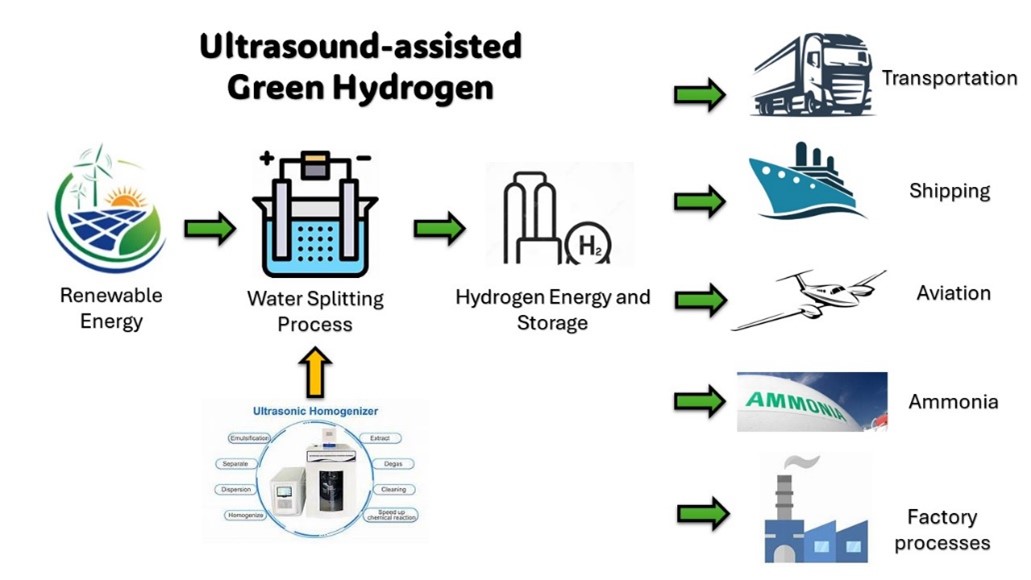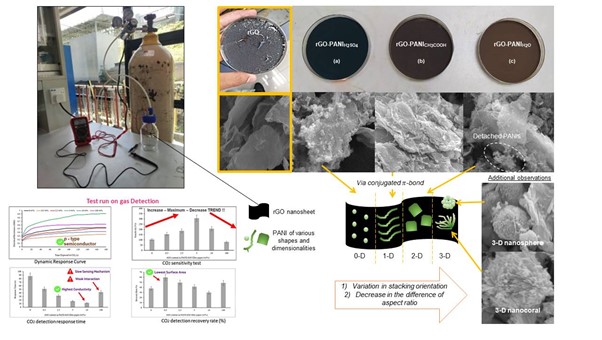Elucidation of Ultrasound and Catalyst Effect on Water Electrolysis by Capillary Feed Technique for Sustainable Hydrogen Production
Grant Scheme: Fundamental Research Grant Scheme (FRGS)
Duration: 3 years (Oct 2023 - Sept 2026)
Principal Investigator (PI): Asst. Prof. Dr. Teng Kah Hou
Amount: RM 167,500.00
Status: On-going
SDG Element: SDG7, SDG13

The Paris Agreement was proposed by the United Nations for climate change mitigation, and it was enforced in November 2016. In alignment with the agreement, more and more countries are targeting carbon neutrality to achieve net-zero carbon emissions. One of the focuses is the application of hydrogen in renewable fuel. Green hydrogen production by electrolysis is widely accepted in the industry but the effectiveness is still relatively low compared to fossil-fuel-based hydrogen production. This study aims to overcome the issue by adopting ultrasound, catalyst, and capillary feed techniques into the electrolyzer. Theoretically, the increase of localized temperature and pressure by ultrasound effect has great improvement in reducing the resistance near the boundary especially when it fastens the bubble detachment from the sonotrode. In a corporation with the capillary feed technique that reduces bubble formation, both adoptions will have a synergic effect in the system thus increasing the effectiveness of the system. On the other hand, the catalyst provides a large number of active sites to allow the reaction to occur rapidly. This research will be carried out by parametric investigation to study the relationship of each parameter with the electrolyser’s effectiveness.
Elucidation of self-healing mechanism for the development of adaptive 3D printed membrane in CO2 separation
Grant Scheme: Fundamental Research Grant Scheme (FRGS)
Duration: 2 years (Oct 2023 - Sept 2025)
Principal Investigator (PI): Asst. Prof. Dr. Lai Li Sze
Amount: RM 85,846.00
Status: On-going
SDG Element: SDG13

In recent years, net-zero carbon emission has emerged as an urgent target to be achieved to mitigate environmental issues caused by climate change. Separation of CO2 as the major greenhouse gas is crucial to achieve SDG 13. Polymeric membranes have been widely commercialized for CO2 separation. However, the performance of the membrane is often limited by its structural and molecular properties. 3D printing has emerged as an alternative fabrication method for the membrane with its high flexibility. Nevertheless, the performance of 3D printed membrane might be deteriorated depending on its lifespan. By introducing external stimuli that can tailor the molecular interaction of the adaptive membrane, the properties of the membrane can be altered with self-healing ability. As a result, the lifespan of the membrane can be prolonged, which lead to cost-saving. 3D printed membrane with complex microstructure and self-healing ability for CO2 separation is yet to be developed. Effect of the external stimuli on the recoverable CO2 separation performance of the membrane remains unclear. Self-healing mechanism of the CO2-selective polymeric membrane is also scarcely reported. In this project, the self-healing mechanism of the membrane under external stimuli will be investigated. Then, the resultant membrane will be evaluated for its CO2 separation performance using the gas permeation testing rig.
Evaluation of Hetero-Interfacial Interactions in Graphene/Conductive Polymer System Towards Sensitivity of a Flexible Sensor
Grant Scheme: Fundamental Research Grant Scheme (FRGS)
Duration: 2 years (Nov 2020 - Oct 2022)
Principal Investigator (PI): Assoc. Prof. Dr. Yeap Swee Pin
Amount: RM 108,812.00
Status: Completed
SDG Element: SDG13

Research on graphene and polyaniline (PANI) for wearable and flexible sensors has grown due to the demands of IR 4.0. This project focused on understanding the interfacial interaction between graphene and PANI and its impact on the electrical and gas detection properties of flexible sensors. By manipulating the acidity, PANI morphologies of globules (0-D), nanotubes (1-D), and plates (2-D) were achieved. SEM analysis confirmed that the 0-D PANIs exhibited better interaction with graphene (better distribution and stacking orientation). The reduced graphene oxide (rGO)/PANI globules (0-D) showed the fastest response and recovery times, with lower electrical resistivity compared to pristine PANI and graphene sensors. These findings contribute to the development of optimized flexible sensors for environmental monitoring, closing the knowledge gap in this field. In the last stage of the study, the effect of PANI shape on CO2 gas detection properties was correlated.





